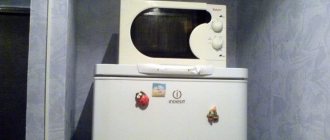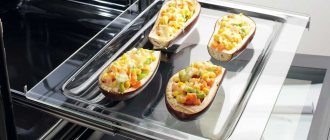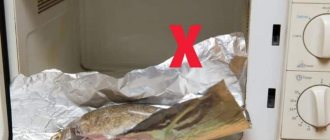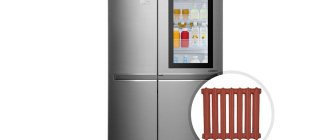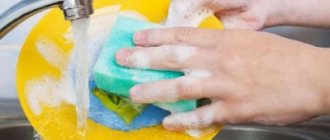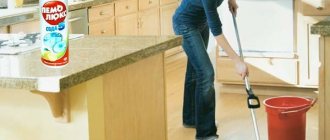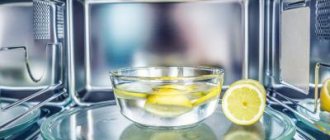If you've ever seen what looks like a miniature lightning bolt in your microwave, it's because you put something metal in it. Metals and microwaves have a complicated relationship. What metal can be used in a microwave oven?
Can you put stainless steel in the microwave? It is best not to place stainless steel in the microwave because the metal reflects microwaves rather than absorbing them. This may cause sparking and fire. This is especially dangerous if the metal has a complex shape, such as forks, or if there is more than one piece of metal present.
In this article, you will learn why putting stainless steel in the microwave is dangerous and why in some cases it is not.
Is it possible to cook in foil in a slow cooker?
A multicooker is not a microwave; you can safely put foil in it. It is very convenient to bake fish, meat, chicken and vegetables in foil.
Interesting materials:
Where can kittens be placed? Where can you go at night in St. Petersburg? Where can you go for a weekend getaway from Tyumen? Where can you go for free in St. Petersburg? Where can you go at night in Tyumen? Where can teenagers go in Minsk? Where can you throw out your emotions? Where does Jack Sparrow go at the end of Pirates of the Caribbean at World's End? Where should I go to apply for a passport? Where can I contact about digital television?
Can be heated in the microwave
- glassware and glass ceramics are an excellent option for preparing and heating dishes. However, in the case of glass, it is important to remember that the dishes should not be too light or too thin - this means that they are made of fusible material and then there is no need to put them in a microwave oven. Glass is also susceptible to temperature changes. In this regard, there is no need to heat food in such a container if it has just been taken out of the refrigerator. It must be remembered that any gold-plated or silver-plated elements immediately restrict the use of this cookware in a microwave oven;
- Ceramic cookware is also microwave safe. However, like glass, it must be of high quality, without cracks and without gilding. In addition, ceramics coated with glaze tolerate heat well, but unglazed pottery clay can crack. It is also important to remember that ceramics get very hot and you need to use oven mitts;
- Silicone molds are suitable for both oven and microwave. Products do not stick to such forms and are easy to cook in. However, if the manufacturer has placed a sticker on the product stating that exposure to radiation is prohibited, then you need to follow the advice, writes the Lifehacker portal;
- baking paper and paper utensils are also used for heating. Paper holds oil and grease and can be used instead of a lid.
Microwaves and metal
Before we take a closer look at why you should or shouldn't put stainless steel in your microwave, it's important to know how this extremely useful appliance works.
How do microwave ovens work?
Microwaves, as a type of radiation , fall between the categories of radio waves and infrared waves. These waves are absorbed by most foods, so they can be heated in seconds.
The atomic movement these waves create in the food causes it to heat evenly.
The only time a microwave will heat food unevenly is if it fails to create a ripple in the center of the dish, be it a large piece of meat or a pile of leftover pasta and sauce.
If you take a minute to distribute the food evenly on your plate, the problem will be solved.
The waves are absorbed by fat, sugar and water in food. There is a common misconception that a microwave oven cooks food from the inside, but this is not true.
If that were the case, you wouldn't have a hot pocket that melts on your face on the outside and a block of ice in the center.
Microwaves actually heat by causing loose molecules in food to spin , creating frictional energy that becomes heat. This heat is then evenly distributed through convection.
The misconception comes from the fact that this process heats the inside of food much faster than an oven, without browning or burning the edges.
What happens when you put metal in the microwave
Now that you know how a microwave oven works, understanding the complex relationship between a microwave oven and metal will be much easier.
Metal and microwave
It is strictly forbidden to place iron utensils in the microwave. The reflective properties of the metal surface block the passage of microwaves through the walls of the container, which causes electrical discharge. If the impact is too strong, the oven mechanism will become unusable. In the most severe cases, an explosion may even occur, since the built-in magnetron cannot cope with the load.
When figuring out whether it is possible to put iron utensils in the microwave, stove owners must keep in mind that it is not only plates and bowls that cannot be used. It is also necessary to ensure that metal spoons, forks, and knives do not get inside.
To the question: “Can I put iron dishes in the microwave?” The answer is clear: “No.” Even plates and cups with gold or silver rims create sparks. A discharge of such force cannot damage the oven itself, but it will leave unsightly dark spots on the plates.
Why is metal taboo for microwaves?
Any user manual supplied with a kitchen appliance emphasizes that metal objects are strictly prohibited from being placed in the oven. Failure to comply with this rule may cause device failure or even a fire. But some people are only spurred on by prohibitions, and they want to see from their own experience what will happen to the metal placed in the microwave.
You can place a small amount of foil in the chamber, for example, when baking a dish, and use thin metal skewers. If unusual sounds, sparks or other phenomena occur, you must immediately turn off the device. It is best not to experiment and use only those dishes for the microwave oven that are intended specifically for it.
Source
How to check that the plate fits
Dishes placed in the oven must fit exactly in size and not touch the walls or top. The diameter of the container should not extend beyond the rotating circle of the oven. If the vessel has handles, then they should also fit clearly into the space. A product of a smaller size is allowed; if it exceeds the required standards, then it is not suitable.
Marking on dishes.
Is it possible to put iron utensils or dishes in foil in the microwave?
Any store, of course, sells dishes specially designed for microwave ovens. It is usually made from fireproof glass, ceramics and special plastic. However, you should not immediately run out and buy it, especially since the prices of such utensils are quite high. You can rummage around in your kitchen, and you will definitely find something suitable there.
Microwave-safe utensils are found in every kitchen.
Stainless steel microwave oven
Stainless steel, which is regular steel coated with a thin layer of chromium, is no different from other types of metal when it comes to putting it in the microwave. It reflects waves just like other metals.
A small, flat piece of stainless steel, when used correctly, is unlikely to cause a spark in a microwave oven. On the other hand, a stainless steel frying pan or fork will certainly work.
Additionally, if you place a stainless steel item too close to the metal walls of the microwave, it may cause severe sparking , damage to the microwave, or even a fire.
Stainless steel is a common material used in travel mugs. Do not attempt to heat these mugs in the microwave.
Not only will your drink stay cold due to the shield created by the metal, but it will also damage your magical kitchen appliances.
Which foil is suitable
There is specialized foil for microwaves, here it is in the photo. It has the properties of high heat resistance and high density, and its composition is somewhat different from the usual one. This foil has through holes so that microwaves can easily penetrate into the food and ensure uniform baking.
It is absolutely not recommended to use food-grade aluminum foil instead of special one. Aluminum is a very soft metal, so radiation from microwaves and very high temperatures causes interaction between it and the products. And the content of this metal in food consumed by humans is fraught with diseases of both the nervous system and kidney and liver diseases.
If you don’t have the necessary foil on hand or in the store, you can heat it in a paper bag or in a baking sleeve.
Source
The right dishes for the microwave
How to choose dishes for the microwave and not make a mistake? Any containers made of heat-resistant glass and heat-resistant plastic are suitable for microwaves. Ordinary ceramic cups and plates can also be used to heat food, but it is still not recommended to cook in them: excessive heating may cause the walls to burst and fragments will fall into the food. For the convenience of users, there are special disposable forms made of thick pressed paper. Plastic containers intended for storing food usually have markings on them that indicate whether the container can be heated in an oven.
Dishes used in the oven must be clean, free of greasy splashes or deposits. When heated, dirt can smoke, which will certainly spoil the quality of food. You also need to carefully monitor the cleanliness of the internal walls of the microwave in order to maximize its service life. Regularly remove plaque from the internal walls, having first disconnected the device from the power supply. To soften the hardest stains, pour water into a large container, add 20 grams of baking soda and 20 ml of table vinegar. Place the liquid inside the microwave and boil for 3-5 minutes. After this, you can proceed directly to cleaning.
Now you know whether you can put iron cookware in the microwave. By abandoning metal in favor of ceramics, porcelain and plastic, you will extend the life of the microwave.
Placing Metal in the Microwave - What You Should Know
If you're not going to read this section, the only thing you should take away is that it's best not to put metal in the microwave unless you're sure it's safe to do so.
If you want to do this correctly, please read the instructions. This applies not only to the instructions for the device you are using, but also to the food you are heating, if the latter refers to products that come in a particular package.
First of all, the manual that came with your appliance will set out the ground rules that you need to follow. It is important to know what is possible and what is not. put it in the microwave.
Last but not least, follow USDA guidelines whenever you are unsure about the safety of cooking a particular material in the microwave.
What does the icon on microwave cookware mean and how to decipher it?
There is a special marking on the dishes that informs the user whether the container can be used in microwave ovens. Please note the variety of notations. Please note the photo of the markings below.
This is how plastic utensils are marked, indicating the composition of the product and its suitability for microwave use.
If you see crossed out icons with the image of microwaves, then the container is not suitable for heating food in the microwave.
Pay attention to what properties microwave cookware should have.
What dishes should not be put in the microwave: comments from the editorial experts
When choosing dishes for the microwave, consultants will show you options of various volumes and shapes. But these are not so important conditions on which the performance of the microwave and your safety depend.
Metal containers are unsafe
Metal and enamel bowls and cups in a working microwave endanger your health. The presence of iron parts in the cookware, not to mention the base of the container, is extremely dangerous for use. The fact is that microwaves do not pass through iron, but, on the contrary, are reflected from it. Accordingly, this phenomenon causes a microwave error, accompanied by sparking and frequent failure of the device.
Utensils with drawings and ornaments
To avoid testing the microwave's performance, avoid plates with gold-plated edges. Agree, it is not known for certain what dyes were used to create such dishes. It is likely that it also contains elements of some metals, and this, as a result, is not permissible for microwave ovens.
Therefore, in order not to take risks, you should refuse containers with such appearance features.
Luxurious crystal is not for the microwave!
An uneven design of the cookware can cause it to split into small pieces. In the production of crystal tableware, which is often a component of antique sets, silver and lead are used, as well as some other natural metals. In addition, due to the cut surface of the cookware, it may crack under the influence of microwaves.
The real reason: why you shouldn't put metal utensils in the microwave?
If the owner violates the rules for operating a microwave oven, no one will repair the device for free. Almost every second owner of a microwave oven had to deal with the problem of having iron cutlery in a working device. It’s good if everything ended well, but events could have developed even more dangerously.
For example, a breakdown of the device, injury to the owner (electric shock), a short circuit and, as a result, a fire. Metal is not able to pass the waves of a microwave device through itself, but repels them back, thereby destroying the functionality of the electrical device.
Requirements for microwave oven dishes when using combined modes
Using containers for microwave ovens is a very important task, so some requirements must be observed. For detailed information, we offer you a detailed video review, which details the main criteria that cookware for microwave ovens must meet.
Cannot be heated in microwave
- products with gold and silver plated elements. Paints contain metal particles that conduct electrical discharges and cause sparks to form. Not only the container may deteriorate, but also a fire may occur;
- metal utensils and cans. The material reflects microwaves rather than transmitting them. The metal begins to spark, which can lead to complete failure of the furnace or even a fire. Enameled metal utensils are also not suitable;
- aluminum foil also reflects the waves rather than absorbing them. As a result, the temperature inside the oven increases and an electric arc is formed, which can cause damage to the device;
- crystal products cannot be heated in a microwave oven, since the material contains metal particles, and the thickness of the faceted walls is not the same. Dishes may crack;
- Wooden utensils have a porous structure and moisture inside. As a result, the material is sensitive to heat. The wood will dry out under the influence of waves;
- plastic that is not resistant to heat, disposable tableware will begin to melt and release harmful chemicals when exposed to strong heat. As a result, a fire may occur.
Cooking some foods in the microwave, such as fish or a lot of garlic, may cause an unpleasant odor. You can get rid of it using folk remedies. You will use lemon, baking soda, table salt and coffee.
